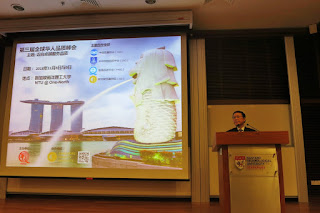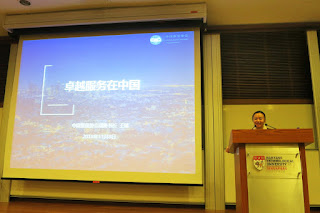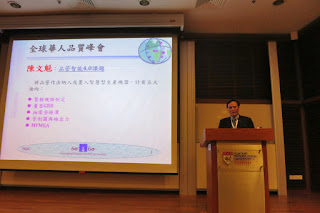The 3rd World Summit for Chinese Quality
(WSCQ) was organized by Pre-World Alliance for Chinese Quality (WACQ) (全球華人品質聯盟(籌)), co-organized by Singapore Quality
Institute (SQI)
at NTU@one-north campus, Executive Centre on 8 Nov 2018. The founding members of Pre-World Alliance
for Chinese included China Association for Quality
(CAQ), Chinese Society for Quality (CSQ), Hong Kong Society for Quality (HKSQ)
and Singapore Quality Institute (SQI).
This Alliance was established after the 3rd Chinese Quality
Forum (CQF) in Beijing in 2015. Minda
and I arrived early and took a photo in NTU@One-North Alumni House with WSCQ
banner.
HKSQ team
took a group photo with CAQ representatives for memory.
(Left: Ms. Wang Lin (王琳) (Deputy Secretary General), Dr. Aaron Tong, I, Prof. Yang Chunyan (楊春燕), Ms. Duan Yihong (段一泓) (Under Secretary, CAQ), Prof. Xingsen Li (李興森) and Ms. Minda Chiang)
We were
surprised to meet RUSSIA team here and took a photo with Ms. Larisa Fedyk (Head
of the Central Organ the System, Federal Agency on Technical Regulating and
Metrology System of Voluntary Certification).
We also
took a group photo with WACQ (including CAQ, CSQ, HKSQ and SQI group)
representatives.
(Left: Ms.
Duan Yihong (段一泓) (CAQ), Mr.
Liu Li Tsung (劉黎宗) (CSQ), Prof.
Xiong wei (熊偉) (CAQ), Prof.
TN Goh (吳桐毅) (SQI), Mr. Tan Gheng Een (陳敬賢) (SQI), Dr. Aaron Tong (唐偉國) (HKSQ), I (HKSQ), Ms. Wang Lin (王琳) and Ms. Wang Lilin (王麗林) (CAQ))
I met Mr.
Kenneth Liang (梁偉賢) (Former
Chairman, SQI).
And then
I took a photo with Mr. Chan Kee Ann (曾祈安) (Vice-Chairman & Education Chairman of
Singapore Quality Institute).
Mr. Johnson Tan (陳川昌) (SQI) was Technical Committee Chair of the summit.
We met
Dr. Dennis Tien (田墨忠) (CSQ) took a photo before the summit.
Dr.
Aaron Tong and I took a photo with Mr. Kent Zhang (張健) (Director, QM Office, Xiaomi
Corporation). Dr. Tong also showed
Xiaomi’s product.
In the beginning, Mr. Chan Kee Ann (曾祈安) (Chairman, Organization
Committee of the 3rd WSCQ) gave opening speech.
Mr. Tan Gheng Een (陳敬賢) gave an opening remark and he
said service quality needed innovative thinking. Moreover, SQI arranged different technical
visit for participants feeling their service culture.
Ms. Wang
Lin (王琳) (Deputy
Secretary General, CAQ) represented WACQ to give welcome speech. Firstly, she briefed the history of the World
Summit for Chinese Quality (WSCQ) that the 1st WSCQ held in Hong
Kong in 2016, the 2nd WSCQ held in Taiwan in 2017, and now the 3rd
WSCQ held in Singapore in 2018. Then she introduced ANQ Asia Service Quality
Award in 2019 and welcome to apply it through each societies under WACQ.
The first keynote speaker Ms. Wang Lin (王琳) (Deputy Secretary General, CAQ) and her topic named “Excellence Service in China” (卓越服務在中國). Firstly, Ms. Wang briefed the overall situation of China Service Industry. Service Industry became the largest industry in China with GDP upto 58.8% in 2017.
Then she said the manufacturing industry and service industry was integrated through high quality development. The development of China service industry had four stages that were preliminary awareness (1978-1991), awareness transformation (1992-2000), awareness acceleration (2001-2005) and completely awareness (2006 to now).
And then Ms. Wang briefed the Service Quality development situation in China. In 1978, TQM was introduced into China and then ISO 9001 employed in 1988. Now, Service Quality in China had a certain level. In 2014, the first announcement of China Service Quality monitoring report was performed. Service Quality was focused continuously.
Finally,
she mentioned the service quality standard work should be enhanced. For instance, after sales service should be
improved based on the survey of manufacturing quality management in 2017. There were four points to be improved and
they were service industry brand image, brand recognition, Perceived quality
and value.
During the
tea break, we met Ms. Rosaline Tong (唐孝菲) who represented Prof. Ching-Chow Yang (楊錦洲) (Former President, CSQ) to
attend the meeting.
Tea
break venue was near the hall.
The
second keynote speaker was Prof. Chen Wen-Kuei (陳文魁) (Professor, I-Shou University;
Director, Kaohsiung Chapter, CSQ) and his topic entitled “Quality Intelligence
4.0” (品管智能4.0課題). Quality management in smart manufacturing had
five directions and they were manufacturing standard, GR&R, Sampling, QCC
and MFMEA.
Then Prof. Chen reviewed industry 1.0 to 4.0 (Steam Era, Electricity Era, Automation Era and IoT Era) and discussed the evolution of Quality Intelligence 4.0 (QI 4.0). He said that the production officer would be moved from frontline to backend (Control Centre). Some technician would become “Manufacturing Supervisor (製造監理員)” and then no more inspector but changed to “Manufacturing Corrector (製造矯正員)”.
After
that Prof. Chen mentioned the quality revolution the required new skills and
epectations for the connected workers.
He described the Quality 1.0 to 3.0 as follows:
Quality
1.0 (13th to 18th century): Craftsman formed a guild (行會) to inspect the process and
trade at that time.
Quality
2.0: (18th to 20th century): In 18th century,
it mainly focused on product inspection.
In 20th century, quality process added into
manufacturing. Unit 1941, US military
used sampling inspection method and then MIL standards issued, as well as,
promoting Shewhart’s SPC.
Quality
3.0: (20th to 21st century): USA was focused on Total
Quality Management (TQM) since 1980 and established Malcolm Baldrige National
Quality Improvement Act in 1987.
Finally,
Prof. Chen reviewed ASQ quality participants’ salary survey in 2018 and found
that statistician was 2nd high salary in the survey. (Higher than
Master Black Belt!). He shared some cases
to explain why statistic was so important.
Dr.
Aaron Tong (唐偉國) (Former Chairman, HKSQ and China
Outstanding Quality Professional, CAQ (中國傑出質量人)) was the third keynote speaker
and his presentation named “-QA vs +QA” (減法質量保證 vs 傳統增量質量保證).
Dr. Tong reviewed the old concepts of quality assurance and quality cost which was the plus QA (+ QA). In fact, total quality cost may not be reduced.
Traditional
method focus on time, service and 3F (Form, Fit and Function). Modern method is
Product plus Service, QC needed to consider cost and delivery time. Therefore, Dr. Aaron Tong proposed the minus
QA (- QA).
After
that he compared the plus QA (+ QA) and the minus QA (- QA) on cost control of
failure, theory and main focus. Minus QA
was due with the “Root Cause” and “Do the Right Thing” so as to reduce
“Appraisal and Preventive Cost”.
Finally,
Dr. Aaron Tong shared his success case in “SUPOR” that employed –QA concept to
reduce the after-sale return rate from 3% to 0.9%.
The last
keynote speaker in the Morning session was Mr. Tan Gheng Een (Chairman, SQI) and his presentation was “Service
Levels and Its Impact on You!” (服務等級及其對您的影響). Mr.
Tan said service was
presented in every aspect of our lives from the moment we were born.
Then Mr. Tan introduced four essential categories high standards for organization success and growth. They were “Products and Services”, “Delivery Systems”, “Service Mindsets” and “Customer Relationships”.
Lastly,
Mr. GE Tan discussed the six level of service each by each. They were “Criminal”, “Basic”, “Expected”, “Desired”,
“Surprising and Unbelievable”.
Finishing
the morning session, WACQ members took a group photo for memory.
(Left: Prof. TN Goh (吳桐毅) (SQI), Dr. KS Chin (錢桂生) (HKSQ), Ms. Ren Baoling (任寳玲) (CSQ), Ms. Duan Yihong (段一泓) (CAQ), Mr. Tan Gheng Een (陳敬賢) (SQI), Ms. Wang Lin (王琳) and Ms. Wang Lilin (王麗林) (CAQ), Dr. Aaron Tong (唐偉國) (HKSQ), Mr. Liu Li Tsung (劉黎宗) (CSQ), Dr. Lotto Lai (黎劍虹) (HKSQ) and Mr. Ivan I.H. Lee (李逸湘) (CSQ))
We also
took a group photo with all participants in the 3rd World Summit for
Chinese Quality.
In
afternoon, there were two parallel sessions.
Session A
The
first speaker in Session A was Mr. Johnson Tan (陳川昌) (SQI) and his topic named “How
to improve service quality through the ISO 9001:2015 quality management system
model” (如何通過 ISO 9001:2015 質量管理體系模型來提升服務質量). Firstly, Mr. Tan introduced Service Quality (SQ) based on comparison of
Expectation (E) about a service with Performance (P) (SQ = P – E).
Then Mr. Johnson Tan briefed different clauses of ISO 9001:2015 covered Quality Management (QM), Business Management (BM) and Risk Management (RM).
After
that he discussed how to measure service quality based on five SQ dimensions
and they were Tangibles, Reliability, Responsiveness, Assurance and Empathy.
Finally,
he mentioned Risk-based thinking based on four practical steps below.
Step 1: Risk
Identification – Systematic use of information to identify hazards.
Step 2:
Risk Estimation – Process used to assign values to the probability of
occurrence of harm and the severity of that harm.
Step 3:
Risk Evaluation – Process of comparing the estimate risk against risk criteria
to determine the acceptability of the risk.
Step 4:
Risk Control – Process in which decisions are made and measures implemented by
which risks are reduced to, or maintained within specified levels.
Where
Risk Analysis was Step 1 plus Step 2, Risk Assessment was Step 1, 2 & 3,
and Risk Management included all four steps.
Lastly,
Mr. Johnson Tan concluded to enhance service quality through integrating QA
practices into business operations such as adoption of appropriate QMS and conducting
training needs analysis.
The second
speaker in Session A was Dr. Ivan Ng (吳志權) (HKSQ) and his presentation was “The Implementation
of Organization Cultural and the Six Sigma Methodology in Southern China” (組織文化與六西格瑪在中國南方的實施). Dr. Ng said not all Chinese
companies suitable to implement 6 sigma because of culture different in East
and West.
In his
study, there were four hypotheses and they were:
i)
Quality objective and six sigma relationship
ii)
Supporting culture enhance the effectiveness of change
iii)
Performance orientation enhance quality and efficiency
iv)
Innovation development and application enhance efficiency and quality.
After survey, interview and data analysis, Dr. Ivan Ng sadi Soft Factors and Hard Factors were core of six sigma success. However, one surprise result was obtained that Innovation Culture created negative effect on developing Six Sigma Quality Culture. Finally, he concluded that organization change related to organization culture. The change objective was an important success factor during implementation of six sigma.
The
third speaker was Mr. Xin-Yang Gao (高辛陽) (CSQ) and his presentation topic entitled “Innovation through Small Improvement
to promote the Great Future” (創新小改善 推動大未來).
Firstly,
Mr. Gao told us the actual meaning of Quality had demonstrated in Chinese
Word. Quality in Chinese Character “品質” that appeared three mouths
(word of mouth) means Brand and 斤斤計貝 means Serious (『三口為品,斤斤以貝計較為質』).
Then he
said Innovation and Improvement were one body two faces. New technologies (e.g.
IoT, AI and Big Data) changed the rules of the world competition that service
quality needed to improve in our daily life.
We needed organization culture on continual improvement.
I (Dr.
Lotto Lai, Chairman of HKSQ) was the four speaker in the Session A and my topic
named “Quality Innovation: From i4.0 to Q4.0”. Firstly, I briefed history of
HKSQ and explained what the meaning of Quality Innovation was.
Then I
summarized quality and innovation tools development trend from Industry 1.0 to
4.0. Using Prof. Cai definition on industry revolution to explain i1.0 was
extension of arm / power; i2.0 was extension of leg, ear and eye; i3.0 extended
part of our brain function; and i4.0 was extension of human intelligence.
Then I
summarized quality and innovation tools development trend from Industry 1.0 to
4.0. Using Prof. Cai definition on industry revolution to explain i1.0 was
extension of arm / power; i2.0 was extension of leg, ear and eye; i3.0 extended
part of our brain function; and i4.0 was extension of human intelligence.
After
that I shared the original i4.0 training from Fraunhofer IPT from Germany. It was a very expensive in-house training
course which HKPC introduced to Hong Kong through government funding. Moreover, HKPC and Fraunhofer as well as KEX
Knowledge Exchange (subsidiary of Fraunhofer) provided tailor-made training
named “Certified i4.0 Professional” to HKSTP.
It costs ~HK$500,000 for 8 people within 5 days training to qualify such
status. I was one of observers (max 3)
to join the workshop.
They
used the Smart i4.0 Navigator as course structure to explain Social-economical
Trends and Technology Trends. From New
Digital Business Models expended to Smart Product, Processes, Networks and
Production through four enablers which were Sensors & Input, Connectivity,
Data Analysis and Output & Actuators.
I then
shared Quality 4.0 views from Prof. Wan Seon Shin and Prof. Mohamed Zairi that
they presented both on Saudi Araba Nation Quality Congress in 2017 and ANQ
Congress in 2018.
Prof.
Wan Seon proposed the Quality Responsibility as quality goad and Open Quality
as quality strategy in Industry 4.0.
Prof.
Mohamed Zairi proposed quality professional to understand Q4.0 principles
included Quality License, Organization Relevant, Quality Orientation Driven,
Transformation, Excellence Maturity and Disruptive Quality Behavior.
At the
end, I briefed the most updated AI issues during the 4th Chinese Congress on
Artificial Intelligence (CCAI2018).
Moreover, I mentioned the new AI text book for high school and
university in 2018. My conclusion was
that Quality Professional needed to study AI and estimate how it could be
affected the future quality management.
The
fifth speaker was Prof. Xiong wei (熊偉) (Professor, School of Management, Zhejiang University) and his
presentation entitled “Research on Nursing Care Quality Control Model based on
Quality Function Deployment” (基於QFD的醫院護理質量控制模型研究). He
said medical service played a more and more important role in people’s
live.
However,
medical service problems came from patients were not satisfaction and medical
argument (from different of awareness between patients and medical
staffs). Prof. Xiong wei proposed to use
QFD model to collect patient’s requirements and transfer to medical service
process specification.
Prof.
Xiong wei study was about hospital nursing care quality control model based on
QFD and combining it with KANO and FMEA so as to improve hospital nursing
service quality. The new model “QFD&KANO&FMEA”
was showed as following diagram.
Lastly,
Prof. Xiong wei discussed the Charismatic Quality Value from Nursing Service
Requirements Digging & Analysis Sub-model.
His study innovatively applied QFD to medical service field integrated
with KANO and FMEA model. In future, Prof.
Xiong wei would try to integrate TRIZ and SECI model to create an optimal path which
could satisfy patient requirements in the premise of cost minimization and
utility maximization.
Ms.
Rosaline Tong (唐孝菲) (Represented Prof. Ching-Chow Yang (楊錦洲)) was the last speaker in
Session A to present the topic entitled “Discussion from China Model to Chinese
Quality” (從中國模式談到華人品質).
Firstly, she mentioned China Model which came from the Book named “Fortune
Makers: The Leaders Creating China’s Great Global Companies”. Some characteristics included China way,
Learning Organization, Agile Strategy, HR Management under Confucianism, Boss Decision
System, Partnership Company Management, etc.
Then she
said China enterprises internationalization was very fast because they learnt
from Europe, USA and Japan. However,
there were four key elements to establish China Model that included Chinese
Culture and Society, Value of Chinese, Society Structure and Custom, as well
as, Law and Regulation.
After
that she mentioned China enterprises learnt from western and those management
system was under localization called “Chinese Concept, Western Standard” (中國理念 西方標準). Best Practice Chinese Companies had
management characteristics included Customer First, Zero tolerance on Quality
Problem, Total staff training and focus on Excellence Culture establishment.
At the
end, Ms. Rosaline Tang concluded that World Alliance for Chinese Quality (WACQ)
had responsibility to establish Chinese Best Practice and Excellence Quality
Operation System for China Enterprises.
Reference:
China Association for Quality (CAQ) - http://www.caq.org.cn/
Chinese Society for Quality (CSQ) - http://www.csq.org.tw/mp.asp?mp=1
Singapore Quality Institute (SQI) - http://www.sqi.org.sg/
Hong Kong Society for Quality (HKSQ) - http://www.hksq.org/index.asp
History (Past Events & Meeting);
20120526:
The first meeting for the Chinese Quality Forum (華人品質論壇) - http://qualityalchemist.blogspot.hk/2012/05/first-meeting-for-chinese-quality-forum.html
20140314:
Pre-Chinese Quality Forum (華人品質論壇) Dinner Meeting 2014 - http://qualityalchemist.blogspot.hk/2014/03/pre-chinese-quality-forum-dinner-meeting.html
20140315:
The 2nd Chinese Quality Forum (華人品質論壇) - http://qualityalchemist.blogspot.hk/2014/03/the-2nd-chinese-quality-forum.html
20150923:
Pre-Chinese Quality Forum (華人品質論壇) Meeting & Dinner 2015 - http://qualityalchemist.blogspot.hk/2015/09/pre-chinese-quality-forum-meeting.html
20151104:
The 15th China Quality Award cum Chinese Quality Forum – Day 1
20151105:
The 15th China Quality Award cum Chinese Quality Forum – Day 2
20151106:
The 3rd Chinese Quality Forum – Day 3 Work Meeting & Visit TusPark
20160707:
The Pre-World Alliance for Chinese Quality (全球華人品質聯盟(籌)) Meeting - http://qualityalchemist.blogspot.hk/2016/07/the-pre-world-alliance-for-chinese.html
20160708:
The 1st World Summit for Chinese Quality - https://qualityalchemist.blogspot.hk/2016/07/the-1st-world-summit-for-chinese-quality.html
20160709:
Post-WSCQ Seminar on Extenics (可拓學) and its application - https://qualityalchemist.blogspot.hk/2016/07/post-wscq-seminar-on-extenics-and-its.html
20160919:
ANQ-CEC and Pre-WACQ Meeting & Dinner 2016 - https://qualityalchemist.blogspot.hk/2016/09/anq-cec-and-pre-wacq-meeting-dinner-2016.html
20171116:
The 2nd World Summit for Chinese Quality – Part 1 - https://qualityalchemist.blogspot.hk/2017/11/the-2nd-world-summit-for-chinese.html
20171116:
The 2nd World Summit for Chinese Quality – Part 2 - https://qualityalchemist.blogspot.hk/2017/11/the-2nd-world-summit-for-chinese_16.html
20171117:
Post - World Summit for Chinese Quality (WSCQ) Technical Visit - https://qualityalchemist.blogspot.hk/2017/11/post-world-summit-for-chinese-quality.html
20181107:
Per – The 3rd World Summit for Chinese Quality (WSCQ) Visit - https://qualityalchemist.blogspot.com/2018/11/per-3rd-world-summit-for-chinese.html
20181108:
The 3rd World Summit for Chinese Quality (WSCQ) – Day 1 (Part A) - https://qualityalchemist.blogspot.com/2018/11/the-3rd-world-summit-for-chinese.html
20181108:
The 3rd World Summit for Chinese Quality (WSCQ) – Day 1 (Part B) - https://qualityalchemist.blogspot.com/2018/11/the-3rd-world-summit-for-chinese_8.html
20181109:
The 3rd World Summit for Chinese Quality (WSCQ) – Day 2 (Technical Visit) - https://qualityalchemist.blogspot.com/2018/11/the-3rd-world-summit-for-chinese_9.html



























































沒有留言:
發佈留言